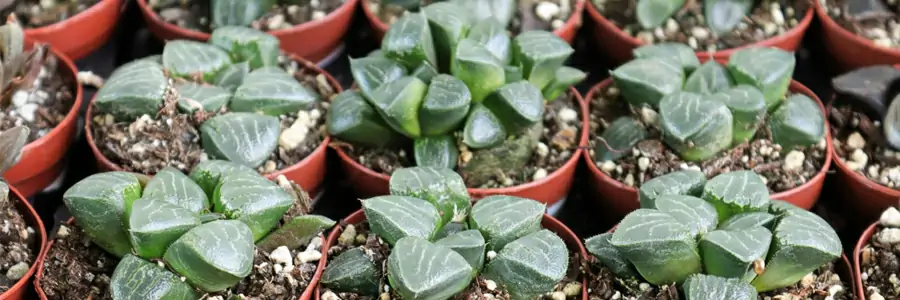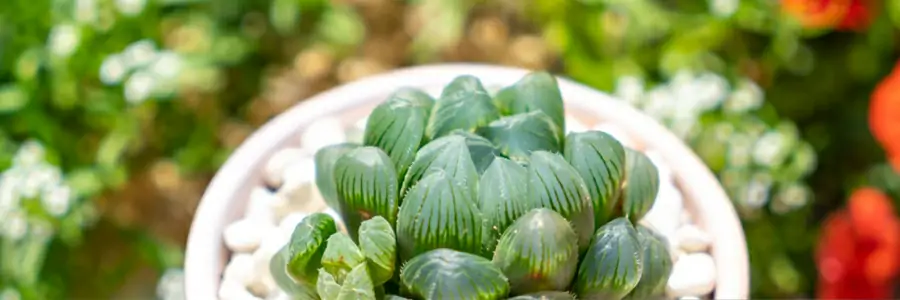Haworthia
Taxonomic Classification
The Haworthia genus belongs to the family Asphodelaceae. Named in honor of the English botanist Adrian Hardy Haworth, this genus encompasses approximately 70 – 80 species of small, succulent plants. These plants are native to southern Africa, thriving in regions with arid and semi – arid climates.

Morphological Characteristics
1.Leaf Structure
Haworthias are characterized by their rosette – shaped growth habit. The leaves, which are the most prominent feature of these plants, are thick and fleshy, adapted for water storage. The leaves can be arranged in a tight, spiral pattern or in a more open, flat – topped rosette. They vary greatly in shape, with some species having long, lance – shaped leaves, while others have short, triangular or rounded leaves.
2.Leaf Texture and Markings
The leaf surfaces of Haworthias often have unique textures and markings. Many species have rough, tuberculate (covered in small bumps) or warty surfaces. Some varieties, like Haworthia cymbiformis var. transiens, have translucent “windows” at the tips of their leaves. These windows allow sunlight to penetrate deep into the plant, enabling photosynthesis even when the plant is partially buried in soil or shaded by surrounding vegetation. The leaves may also be marked with stripes, dots, or patterns, which can vary in color from white, gray, to green, and sometimes with a tinge of red or purple, especially when the plants are stressed by environmental factors such as strong sunlight or drought.
Common Varieties
1.Haworthia cooperi
This species is highly popular among succulent enthusiasts. It has small, compact rosettes with thick, triangular – shaped leaves. The leaves are often translucent towards the tips, giving them a unique, almost glass – like appearance. There are several varieties of Haworthia cooperi, some with smooth leaves and others with more textured surfaces. The plants are relatively easy to care for and can be grown both indoors and outdoors in suitable climates.
2.Haworthia fasciata
Also known as Zebra Cactus, Haworthia fasciata is characterized by its distinct white, horizontal stripes on its dark green leaves. The rosettes are usually flat – topped and can grow up to 10 centimeters in diameter. This species is relatively hardy and can tolerate a wide range of light conditions, although it thrives best in bright, indirect light. It is a common sight in succulent collections and is often used in small potted arrangements or as part of a mixed succulent garden.
3.Haworthia attenuata
Haworthia attenuata has long, lance – shaped leaves that form loose rosettes. The leaves are covered in small, white tubercles, giving them a rough texture. The plant can grow up to 15 centimeters tall and is known for its ability to produce offsets freely, forming small clusters over time. It is a relatively adaptable species and can tolerate more light than some other Haworthias, but still prefers bright, indirect light to avoid leaf damage.
4.Haworthia cymbiformis
This species has a unique, boat – shaped (cymbiform) leaf structure. The rosettes are compact, and the leaves can be either smooth or have small, raised dots. There are various forms of Haworthia cymbiformis, some with more flattened rosettes and others with more upright growth. The plants are relatively slow – growing but are highly prized for their interesting leaf shape and texture. They are well – suited for small, decorative pots and can be a focal point in a succulent display.
5.Haworthia retusa
Haworthia retusa has short, thick leaves that are rounded at the tips and often curve slightly downwards. The rosettes are small, usually less than 5 centimeters in diameter. The leaves may have a smooth or slightly textured surface and can range in color from light green to a more bluish – green. This species is relatively easy to propagate and is a great choice for beginners in succulent cultivation. It can be grown indoors on a windowsill or in a small outdoor succulent garden.

